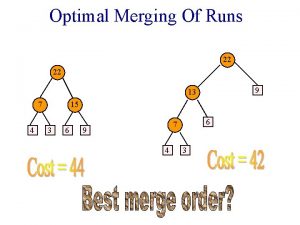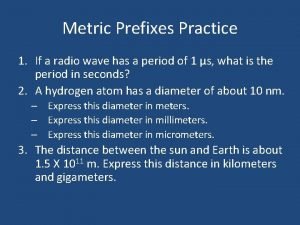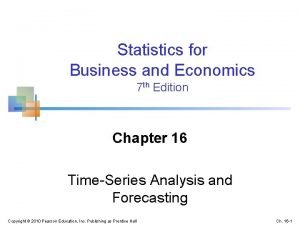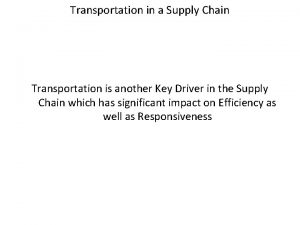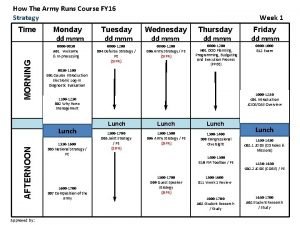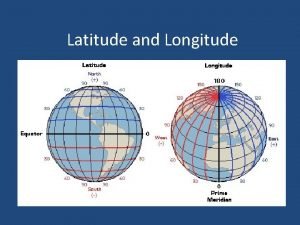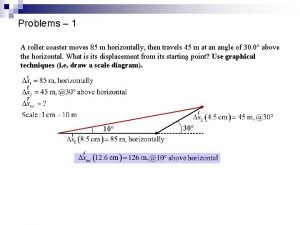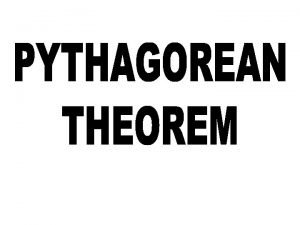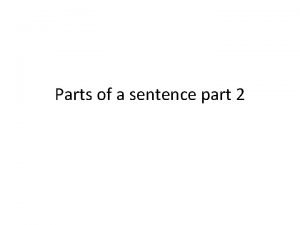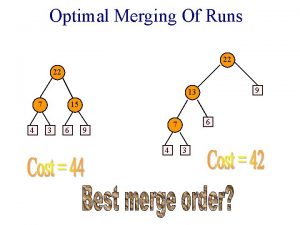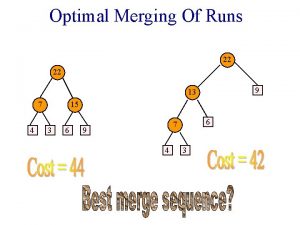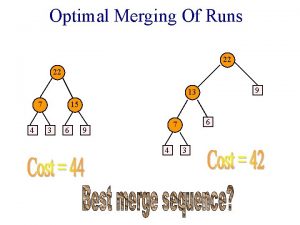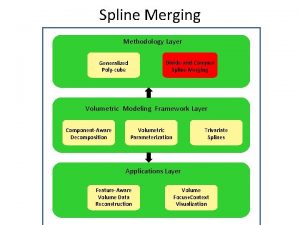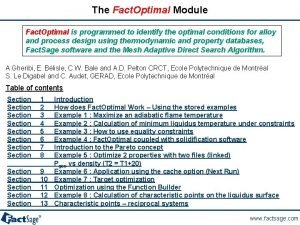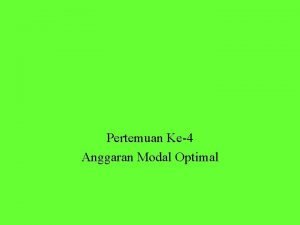Optimal Merging Of Runs 22 22 9 13





![Example • • n = 4 messages. The frequencies are [2, 4, 8, 100]. Example • • n = 4 messages. The frequencies are [2, 4, 8, 100].](https://slidetodoc.com/presentation_image/11fbf938061917035828dc20de89b4d4/image-6.jpg)








![Example • n = 5, w[0: 4] = [2, 5, 4, 7, 9]. 2 Example • n = 5, w[0: 4] = [2, 5, 4, 7, 9]. 2](https://slidetodoc.com/presentation_image/11fbf938061917035828dc20de89b4d4/image-15.jpg)
![Example • n = 5, w[0: 4] = [2, 5, 4, 7, 9]. 5 Example • n = 5, w[0: 4] = [2, 5, 4, 7, 9]. 5](https://slidetodoc.com/presentation_image/11fbf938061917035828dc20de89b4d4/image-16.jpg)
![Example • n = 5, w[0: 4] = [2, 5, 4, 7, 9]. 7 Example • n = 5, w[0: 4] = [2, 5, 4, 7, 9]. 7](https://slidetodoc.com/presentation_image/11fbf938061917035828dc20de89b4d4/image-17.jpg)
![Example • n = 5, w[0: 4] = [2, 5, 4, 7, 9]. 11 Example • n = 5, w[0: 4] = [2, 5, 4, 7, 9]. 11](https://slidetodoc.com/presentation_image/11fbf938061917035828dc20de89b4d4/image-18.jpg)
![Example • n = 5, w[0: 4] = [2, 5, 4, 7, 9]. 27 Example • n = 5, w[0: 4] = [2, 5, 4, 7, 9]. 27](https://slidetodoc.com/presentation_image/11fbf938061917035828dc20de89b4d4/image-19.jpg)






- Slides: 25

Optimal Merging Of Runs 22 22 9 13 7 4 15 3 6 6 7 9 4 3

Weighted External Path Length WEPL(T) = S(weight of external node i) * (distance of node i from root of T) 22 7 4 WEPL(T) = 4 * 2 + 3*2 + 6*2 + 9*2 = 44 15 3 6 9

Weighted External Path Length WEPL(T) = S(weight of external node i) * (distance of node i from root of T) 22 9 13 6 7 4 3 WEPL(T) = 4 * 3 + 3*3 + 6*2 + 9*1 = 42

Other Applications • Message coding and decoding. • Lossless data compression.

Message Coding & Decoding • Messages M 0, M 1, M 2, …, Mn-1 are to be transmitted. • The messages do not change. • Both sender and receiver know the messages. • So, it is adequate to transmit a code that identifies the message (e. g. , message index). • Mi is sent with frequency fi. • Select message codes so as to minimize transmission and decoding times.
![Example n 4 messages The frequencies are 2 4 8 100 Example • • n = 4 messages. The frequencies are [2, 4, 8, 100].](https://slidetodoc.com/presentation_image/11fbf938061917035828dc20de89b4d4/image-6.jpg)
Example • • n = 4 messages. The frequencies are [2, 4, 8, 100]. Use 2 -bit codes [00, 01, 10, 11]. Transmission cost = 2*2 + 4*2 + 8*2 + 100*2 = 228. • Decoding is done using a binary tree.

Example 0 1 2 4 8 100 M 1 M 2 M 3 • Decoding cost = 2*2 + 4*2 + 8*2 + 100*2 = 228 = transmission cost = WEPL

Example • Every binary tree with n external nodes defines a code set for n messages. 0 • Decoding cost 1 100 0 1 8 0 2 1 4 M 0 M 1 M 2 M 3 = 2*3 + 4*3 + 8*2 + 100*1 = 144 = transmission cost = WEPL

Another Example 0 0 M 0 1 M 2 M 3 0 1 1 0 0 1 M 4 M 5 0 1 M 8 M 6 M 7 No code is a prefix of another! 1 M 9

Lossless Data Compression • Alphabet = {a, b, c, d}. • String with 10 as, 5 bs, 100 cs, and 900 ds. • Use a 2 -bit code. § a = 00, b = 01, c = 10, d = 11. § Size of string = 10*2 + 5*2 + 100*2 + 900*2 = 2030 bits. § Plus size of code table.

Lossless Data Compression • Use a variable length code that satisfies prefix property (no code is a prefix of another). § a = 000, b = 001, c = 01, d = 1. § Size of string = 10*3 + 5*3 + 100*2 + 900*1 = 1145 bits. § Plus size of code table. § Compression ratio is approx. 2030/1145 = 1. 8.

Lossless Data Compression 0 0 1 0 a 1 1 d c b • Decode 0001100101… • addbc… • Compression ratio is maximized when the decode tree has minimum WEPL.

Huffman Trees • Trees that have minimum WEPL. • Binary trees with minimum WEPL may be constructed using a greedy algorithm. • For higher order trees with minimum WEPL, a preprocessing step followed by the greedy algorithm may be used. • Huffman codes: codes defined by minimum WEPL trees.

Greedy Algorithm For Binary Trees • Start with a collection of external nodes, each with one of the given weights. Each external node defines a different tree. • Reduce number of trees by 1. § Select 2 trees with minimum weight. § Combine them by making them children of a new root node. § The weight of the new tree is the sum of the weights of the individual trees. § Add new tree to tree collection. • Repeat reduce step until only 1 tree remains.
![Example n 5 w0 4 2 5 4 7 9 2 Example • n = 5, w[0: 4] = [2, 5, 4, 7, 9]. 2](https://slidetodoc.com/presentation_image/11fbf938061917035828dc20de89b4d4/image-15.jpg)
Example • n = 5, w[0: 4] = [2, 5, 4, 7, 9]. 2 5 4 7 99
![Example n 5 w0 4 2 5 4 7 9 5 Example • n = 5, w[0: 4] = [2, 5, 4, 7, 9]. 5](https://slidetodoc.com/presentation_image/11fbf938061917035828dc20de89b4d4/image-16.jpg)
Example • n = 5, w[0: 4] = [2, 5, 4, 7, 9]. 5 7 6 2 4 9
![Example n 5 w0 4 2 5 4 7 9 7 Example • n = 5, w[0: 4] = [2, 5, 4, 7, 9]. 7](https://slidetodoc.com/presentation_image/11fbf938061917035828dc20de89b4d4/image-17.jpg)
Example • n = 5, w[0: 4] = [2, 5, 4, 7, 9]. 7 11 5 6 2 4 9
![Example n 5 w0 4 2 5 4 7 9 11 Example • n = 5, w[0: 4] = [2, 5, 4, 7, 9]. 11](https://slidetodoc.com/presentation_image/11fbf938061917035828dc20de89b4d4/image-18.jpg)
Example • n = 5, w[0: 4] = [2, 5, 4, 7, 9]. 11 5 16 6 2 7 4 9
![Example n 5 w0 4 2 5 4 7 9 27 Example • n = 5, w[0: 4] = [2, 5, 4, 7, 9]. 27](https://slidetodoc.com/presentation_image/11fbf938061917035828dc20de89b4d4/image-19.jpg)
Example • n = 5, w[0: 4] = [2, 5, 4, 7, 9]. 27 11 5 16 6 2 7 4 9

Data Structure For Tree Collection • Operations are: § Initialize with n trees. § Remove 2 trees with least weight. § Insert new tree. • • • Use a min heap. Initialize … O(n). 2(n – 1) remove min operations … O(n log n). n – 1 insert operations … O(n log n). Total time is O(n log n). Or, (n – 1) remove mins and (n – 1) change mins.

Higher Order Trees • Greedy scheme doesn’t work! • 3 -way tree with weights [3, 6, 1, 9]. 19 19 3 6 4 9 10 1 Greedy Tree Cost = 29 3 6 1 Optimal Tree Cost = 23 9

Cause Of Failure 19 0 10 3 6 1 9 Greedy Tree Cost = 29 • One node is not a 3 -way node. • A 2 -way node is like a 3 -way node, one of whose children has a weight of 0. • Must start with enough runs/weights of length 0 so that all nodes are 3 -way nodes.

How Many Length 0 Runs To Add? • • k-way tree, k > 1. Initial number of runs is r. Add least q >= 0 runs of length 0. Each k-way merge reduces the number of runs by k – 1. • Number of runs after s k-way merges is r + q – s(k – 1) • For some positive integer s, the number of remaining runs must become 1.

How Many Length 0 Runs To Add? • So, we want r + q – s(k– 1) = 1 for some positive integer s. • So, r + q – 1 = s(k – 1). • Or, (r + q – 1) mod (k – 1) = 0. • Or, r + q – 1 is divisible by k – 1. § This implies that q < k – 1. (r – 1) mod (k – 1) = 0 => q = 0. l (r – 1) mod (k – 1) != 0 => q = k – 1 – (r – 1) mod (k – 1). • Or, q = (1 – r) mod (k – 1). l

Examples • k = 2. § q = (1 – r) mod (k – 1) = (1 – r) mod 1 = 0. § So, no runs of length 0 are to be added. • k = 4, r = 6. § q = (1 – r) mod (k – 1) = (1 – 6) mod 3 = (– 5)mod 3 = (6 – 5) mod 3 = 1. § So, must start with 7 runs, and then apply greedy method.
 Optimal merging of runs
Optimal merging of runs Longitudinal and transverse framing system
Longitudinal and transverse framing system The merging area of an entrance ramp is marked by
The merging area of an entrance ramp is marked by Guided practice
Guided practice Nathan accelerates his skateboard uniformly
Nathan accelerates his skateboard uniformly Runs test
Runs test A football player runs directly down the field for 35 m
A football player runs directly down the field for 35 m A river runs through it explained
A river runs through it explained Shipping via dc using milk runs
Shipping via dc using milk runs Over the mountains and the sea your river
Over the mountains and the sea your river When abstract moralizing runs amok
When abstract moralizing runs amok How the army runs
How the army runs Horizontal lines that separates from west
Horizontal lines that separates from west What velocity must a 1210 kg car
What velocity must a 1210 kg car Mara runs faster than gail
Mara runs faster than gail During the summer alex runs a lawn-mowing service
During the summer alex runs a lawn-mowing service Two line headline examples
Two line headline examples What are the 7 continents and 5 oceans
What are the 7 continents and 5 oceans A novice pilot sets a plane's controls
A novice pilot sets a plane's controls Forces that change motion quick check
Forces that change motion quick check Joseph runs 2 1/2 miles on monday
Joseph runs 2 1/2 miles on monday Oscars dog house is shaped like a tent
Oscars dog house is shaped like a tent A channel runs almost parallel to a river
A channel runs almost parallel to a river Pam runs a mail-order business for gym equipment
Pam runs a mail-order business for gym equipment Sally (run, runs) to the park every day.
Sally (run, runs) to the park every day. Ndito runs laurie halse anderson
Ndito runs laurie halse anderson
